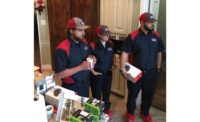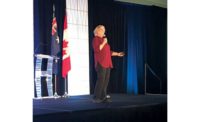DALLAS — Discussing the HVACR industry at Tempo Air of Dallas is not ordinary counter talk or the typical complaints one might hear while sipping a cold one after work. If you walk into the Tempo building near the site of the old Dallas Cowboys stadium and ask for opinions about the industry and the economy, you better take good notes, because the slow-talking Texans have a lot to say.
The NEWS interviewed Steve Saunders, CEO, Tempo Partners; David Gannon, COO, Tempo Partners; and Joey Brown, vice president, Tempo Service. Following are their insights.
NEWS: Given that all business is local, how do you respond to this: The HVAC industry has grown every year since 2011, according to Air-Conditioning, Heating and Refrigeration Institute (AHRI) shipments. To what do you attribute that growth and how long can it continue?
Saunders: We are lucky to be in DFW [Dallas-Fort Worth]. It may be the strongest, healthiest business market in the country. In some ways, the market is so good, you have to be careful about how much work you go get because it could be easy to outsell your ability to perform. You have to keep a balance about your ability to deliver work as well as your ability to get work. We are more diverse than most. We have to manage our construction business, our service business, and our energy rating business — all to say, where is the opportunity, how do we grow? Then client selection is really important, because you can get a lot of business from clients that may not be durable, that may not be around at the next downturn. And what you really want is the client that has long-term enduring business dreams, because we’re going to have a downturn someday. So we want to be picking our clients for their ability and desire to not only have a long-term relationship, but their ability and desire to pay. Because you can get a lot of clients that are happy to sign contracts with you but not as happy to hold up their end of the agreement.
NEWS: How will the tariffs imposed by the U.S. affect this industry?
Gannon: We’ve certainly been notified by several of our key suppliers that they are going to implement some increases in the range of 3 to 6 percent. What we see mostly is a shortage of long-haul drivers; we can’t get equipment on a timely basis. This is a shortage that’s real. The tariffs haven’t really affected our business so much. But this lack of getting deliveries from our manufacturers to our distributors is affecting our business. Very few people use company drivers anymore; they are all contract drivers, and the shortages affecting our manufacturing partners are affecting us.
NEWS: Is this just a general labor issue?
Gannon: That is an individual thing. There is a general labor shortage that we find throughout the trades on the service and construction side. There was a time a few years back when we could not take on new business because of labor shortages, but things have eased, and we are again acquiring new builders and contractors.
Saunders: Tariffs will not hurt service for a while. The more likely impact for tariffs is an overall construction slowdown. What we already see in markets all across the country is the price per square foot going up, partly due to material cost, partly due to labor costs and labor availability. And there is a delay of construction, so what took 90 days from slab to finish now takes 180 days on many builders’ schedules. So the interest cost for that extra 90 days is a pretty big burden on their minds. When you start adding up tariffs for lumber, tariffs for HVAC equipment (really all steel products), tariffs for other things, what we may end up seeing is price points getting to where people’s wages don’t go up commensurately and not being able to afford housing. So different housing choices are being made, then no housing choices are being made, and we see some disruption in this overall economic boom.
NEWS: Is there lag time before effects such as tariffs are felt in Dallas?
Saunders: Well, it’s hard to say — Dallas-Fort Worth feels more insulated than maybe Evansville, Indiana, or Decatur, Illinois, or lots of other markets in the country. I think we have, in the mega-cities, some trends that keep us more insulated for a while, such as jobs growth and migration ... but I think these things have a tendency to build up, and then all of a sudden, while everything is rolling in the background and nobody sees it, it’s kind of like the whole October 2008 thing. There is a trigger event, and all of a sudden the world is different, and everybody asks “What happened?” What worries me about this current tariff effect is that we’re going to have some other trigger event, with all this other stuff in the background, and we are going to look up and say, “Where did all our robust economic growth go?”
Gannon: You’re looking at a perfect storm, with interest rates increasing and your tariffs and general materials cost also going up. It’s going to make home ownership more difficult, and we’re finding that in Dallas, even though home prices are still going up, they are increasing at a slower rate.
NEWS: If you were talking to a contractor who wanted to grow his business, what would that advice be?
Gannon: Shed debt. We found in the last recession that you have to be ready. The ones that are still around and are successful are those that had the smaller amount of debt.
Brown: Always be looking for high-performing talent at every position; you must have the right people in the seats on the bus.
Saunders: I would add building customer loyalty. In every market segment you compete in, you can’t get overconfident with a good economy — you have to deliver today, you have to build the loyalty today — you will need it tomorrow.
NEWS: What is one big trend to be watching for in the next two to five years?
Saunders: Information management. How do you translate all the data from all the segments of your business into information so that it is actionable for those people who are closest to the customer?
NEWS: What are your thoughts on connectivity in the home and IoT?
Brown: Getting our business in front of our customers, whether it be through a Wi-Fi thermostat device accessible from their cellphone or some future device in the home, is going to grow in importance in our industry. With Amazon and Nest changing a lot of business models, it’s going to manifest in the trades, especially HVACR and electrical.
NEWS: On the residential side, how does a contractor cash in on the smart home momentum?
Brown: Keeping technicians trained on the latest and greatest smart home technology is very important. Ultimately, customers purchase products and services from companies they trust — embrace the current trends, and offer what interests the consumer.
Originally, I was focused on the possible negative effects of losing customers to global giants like Google and Amazon. “What are they going to do to our business? We can’t let that happen.”
It is going to happen because people want instant information. And they don’t want to work hard at getting that information. The bottom line is to take care of your customers or someone else will.
NEWS: Do you work at managing social media?
Brown: We have a partner [Tempo employees are referred to as partners] who manages our social media for our service department. Whether it be a partner or you bring in a company to manage your efforts, and we have done it both ways, it is an important aspect.
Gannon: We don’t see a lot of leads coming in from social media yet. We have seen more activity in neighborhood chat sites; local homeowner associations are good lead sources.
Saunders: We work hard on reviews; we have about 2,500 online reviews today, and I think our average across several sites is 4.9 out of a possible five. The best way to manage social media is to just not get bad reviews in the first place.
NEWS: Is ductless here to stay? Is it going to grow?
Gannon: It’s here to stay. It’s a pig to some, a beauty to others, but it is certainly popular around the world. It is a specialty product for us; we’ve done a few demonstration houses with totally ductless, but only a few.
Saunders: I think we are going to see continued growth in the inverter compressor market. Inverter products are probably not properly represented in performance with SEER, EER, and HSPF. One of the big changes we will see over time is when there are alternative rating methodologies that capture the full value of inverter compressors and their ability to operate effectively and efficiently in nonpeak seasons. In construction, ductless is a hard retrofit for a ducted system — in part because of the aesthetic issue and in part because of the condensate placement. New construction works better. I’d be interested to see how the performance of the product fares as the envelope of homes continues to improve and load calculations shrink. The option of regular compression performance really doesn’t do very well, particularly in humidity removal. What we might find with these long-term trends is that ductless could be a better product and the market catches up to it. Right this minute, it’s not there yet.
NEWS: Do you run into problems where today the homes are too tightly constructed?
Gannon: We have had problems, but you can control it. For example, if you tighten up the home, you can introduce fresh air when and how you want to. There is no doubt you have to have fresh air. You have to know how to install a system properly for a home that is tightly built.
NEWS: Is fresh air one of the biggest misses today?
Gannon: Mismanaged, yes.
Saunders: Fresh air is poorly handled many times in our industry. So fresh air is one, oversized ductwork another. We call it the HAC industry because air conditioning contractors have generally ceded the V to someone else. The world is trying to give it back to them, but you have to get the design right, you have to install to the design, you have to ventilate appropriately, and commissioning is more important than it used to be. All those elements are tied to having performance improvement.
What we have seen in new construction is we had two big thrusts in the last nine years or so. One was to improve the envelope, and one was to improve the air conditioning. The envelope part got done, but the air conditioning part was much less successful.
Now, today, we’re having some complexity problems because the home envelope is better and the air conditioning is the same. The “better” home is better; but the HVAC industry has not done a good job of adjusting.
Saunders: It’s not just a problem of HVAC contractors being uninterested. It’s an entire channel discussion about infrastructure over aesthetic choices that needs to continually take place with contractors, builders, and owners.
NEWS: What would you ask of distributors or manufacturers?
Gannon: Certainly the engineering training; we’ve always been of the philosophy that there is a lot of good equipment available in the market and what really counts is the design and the installation.
The best brand on a poor design is a poor product.
Brown: Requiring warranty registration documentation, or even requiring maintenance for warranty validation; every manufacturer requires maintenance, but it’s not often enforced.
Publication date: 9/17/2018
Want more HVAC industry news and information? Join The NEWS on Facebook, Twitter, and LinkedIn today!





